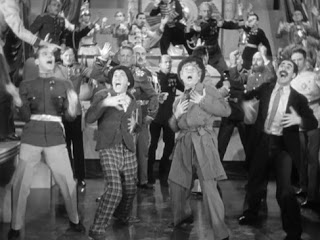

The Golden Age of Comedy (Post 12 of 12: The final battle)
Chaplin Fan: Good evening and welcome to Classic Movies Revisited. Tonight we are going to dredge up a debate that’s been going on for over eighty years. That is, deciding who was the king of silent film comedians, Charlie Chaplin or Buster Keaton. I’m Chaplin Fan. And please, let’s stick to the films and not hold against Charlie his succession of teenage wives or any political views.
Keaton Fan: And I’m Keaton Fan. And yes, don’t hold against my guy that he later appeared in Beach Blanket Bingo.
Chaplin Fan: Deal. Go on.
Keaton Fan: My submission for the jury is Buster’s 1926 classic The General and since we need to have a short as well, I have chosen The Paleface from 1922. Why, The Paleface? Well, because I had a copy handy on VHS.
Chaplin Fan: My submission for the jury is Charlot’s 1931 classic City Lights and since I needed to pick a short as well, I chose The Pawnshop from 1916. Why did I choose The Pawnshop? Because I had a Super 8mm copy of this film in the 70’s. and I wanted to relive the memory. So make your case for The Great Stone Face.
Keaton Fan: Gladly. First of all, the most important question to answer about any silent comedy is: was it funny? Well, yes. Keaton films are damn funny. You want physical comedy? Nobody could do their own stunts like Keaton. He was an amazing visual artist. He could make something simple like about to get burned at the stake in The Paleface funny just by moving slightly away from where the tribe is about to light the fire underneath him. And the stunts on the train during The General are not only funny, they forwarded the plot and some of them makes you wonder how in the world did he do that? And he wasn’t all about stunts. Subtle scenes like the Union general burning a hole in the tablecloth and Keaton using the hole to catch a glimpse of his true love were great. Chaplin was always the one that had a reputation for demonstrating pathos or sympathy for his character, but look at the final scene of The General where Keaton states his occupation as “soldier.” I dare you not to shed a tear to that one. Now make your case for The Little Tramp.
Chaplin Fan: Thank you. In viewing The Pawnshop and City Lights, I noticed Charlie’s growth from the most popular movie star in the world to the greatest artist in the world. Charlie could find comic gold in getting caught in a ladder, fixing a cuckoo clock or accidentally foiling a heist. And in City Lights, how can you beat the opening scene of the unveiling of a statue with the Little Tramp on its lap. And the last shot of the tramp smiling when the blind flower girl regains her sight. Find a more touching ending of any movie. EVER! I haven’t even talked about the boxing scene. Hilarious, masterful and better every time you see it. Charlie always worked with great supporting foils and feemes. John Rand, Edna Purviance and others in his films were the greatest supporting comic actors of the day and Chaplin wasn't afraid to use them-
Keaton Fan: -Hold on a second. Why are we arguing?
Chaplin Fan: I don’t know. We’ve always argued about this.
Keaton Fan: Why don’t we work together? I think Chaplin was great, just not as great as Keaton.
Chaplin Fan: And I think Keaton was great, just not as great as Chaplin.
Keaton Fan: Isn’t it hard enough to get a modern audience to appreciate any black & white movie, yet alone a silent one?
Chaplin Fan: I’m with you. It’s a comic art form in cinema that was unique and will never come back. Let’s appreciate it.
Keaton Fan: Work together?
Chaplin Fan: Together.
Keaton Fan and Chaplin Fan shake hands.
Keaton Fan and Chaplin Fan stare at each other in silence.
Keaton Fan: (pointing) Keaton is number one!
Chaplin Fan: (pointing back) Chaplin is number one!
Keaton Fan huffs and exits stage left.
Chaplin Fan huffs and exits stage right.
A giant title card drops on the stage which reads: THE END


















































.jpg)


